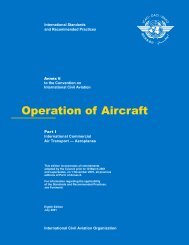Aircraft Operations
Doc 8168 Aircraft Operations, Volume I Flight Procedures
Doc 8168 Aircraft Operations, Volume I Flight Procedures
- No tags were found...
You also want an ePaper? Increase the reach of your titles
YUMPU automatically turns print PDFs into web optimized ePapers that Google loves.
II-3-1-4<br />
Procedures — <strong>Aircraft</strong> <strong>Operations</strong> — Volume I<br />
An FMC using GNSS will contain either the three system modes of operation described above, or be required to<br />
operate in conjunction with a flight director system or coupled autopilot system to ensure the required level of<br />
performance is provided.<br />
1.2.7 Course deviation indicator (CDI) sensitivity<br />
1.2.7.1 The CDI sensitivity is automatically coupled to the operating mode of the receiver. Its settings are:<br />
a) ±9.3 km (5.0 NM) in en-route mode;<br />
b) ±1.9 km (1.0 NM) in terminal mode; and<br />
c) ±0.6 km (0.3 NM) in approach mode.<br />
1.2.7.2 Although a manual selection for CDI sensitivity is available, the pilot may only manually select a CDI<br />
sensitivity other than ±0.6 km (0.3 NM). Overriding an automatically selected CDI sensitivity during an approach will<br />
cancel the approach mode and approach mode annunciation.<br />
1.2.7.3 Some FMC GNSS implementations may incorporate different display sensitivities for approach operations<br />
from those shown above. These different display sensitivities may be used when guidance is provided by a flight<br />
director or autopilot. Regardless of the approach display sensitivity differences between FMC GNSS implementations,<br />
equivalent integrity must still be provided.<br />
1.3 PRE-FLIGHT<br />
1.3.1 Prior to IFR flight operations using basic GNSS receivers, the operator should ensure that the equipment<br />
and the installation are approved and certified for the intended IFR operation, as not all equipment is certified for<br />
approach and/or departure procedures.<br />
1.3.2 Prior to any basic GNSS IFR operation, a review of all the NOTAMs appropriate to the satellite<br />
constellation should be accomplished.<br />
Note.— Some GNSS receivers may contain the capability to deselect the affected satellite.<br />
1.3.3 The pilot/operator must follow the specific start-up, initialization, and self-test procedures for the equipment<br />
as outlined in the aircraft operating manual.<br />
1.3.4 For an FMC system, any special conditions or limitations for approach operations and alternatives will be<br />
specified in the aircraft operating manual. One type may utilize steps identical to those described above. Other types<br />
may require an operations control centre to perform an assessment of RAIM availability and provide this data as part of<br />
the flight dispatch information.<br />
1.3.5 For basic GNSS stand-alone receivers, the pilot shall select the appropriate airport(s), runway/approach<br />
procedure and initial approach fix on the aircraft’s GNSS receiver to determine RAIM availability for that approach.<br />
Air traffic services personnel may not be able to provide any information about the operational integrity of the<br />
navigation services and approach procedure. This is especially important when the aircraft has been “cleared for the<br />
approach”. Procedures should be established in the event that GNSS navigation outages are predicted or occur. In these<br />
situations, the pilot must revert to an alternative method of navigation.<br />
23/11/06












